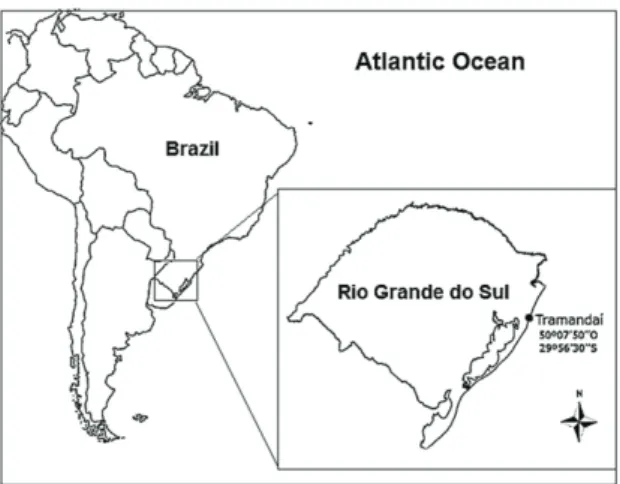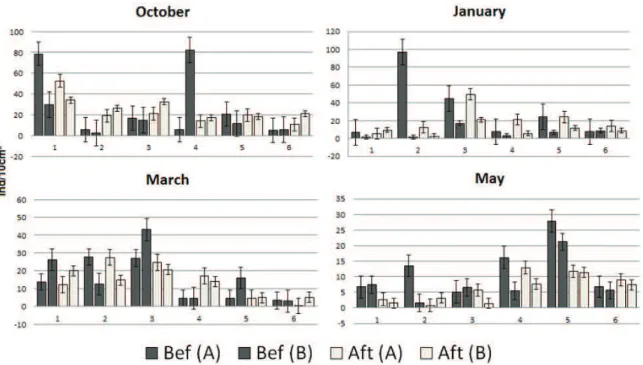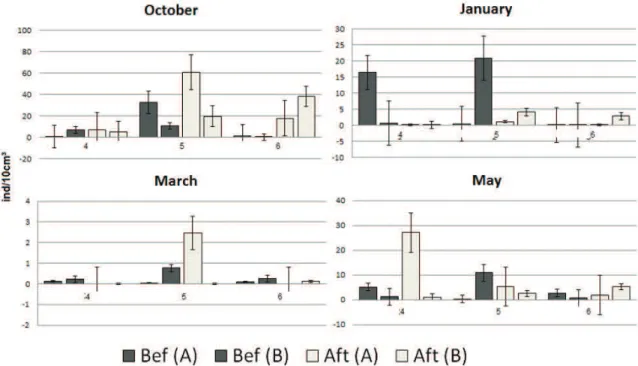Received: November 9, 2015 Approved: August 23, 2016
* Paper presented in the International Sandy Beach Symposium, 7. 2015, Ilhabela, São Paulo, Brazil .
http://dx.doi.org/10.1590/S1679-87592017116006504
According to MCLACHLAN; BROWN (2006), san-dy beaches are extremely san-dynamic environments and the interaction of winds, waves, tides and sediments is the main reason for their instability. They are usually more
affected by storm surges than by other factors such as pol -lution and disruption of sediment transport. Storm surges are episodic phenomena caused by a rise in the average expected sea level by an astronomical component associ-ated with weather conditions like cold fronts, hurricanes and cyclones (PUGH, 1987; VIEIRA, RANGEL, 1988). Their impact is higher on exposed beaches with micro-tide regime due to the large amounts of sediment transport and erosion that occur during the phenomenon (MACHADO et al., 2010; MCLACHLAN; BROWN, 2006; VIEIRA; RANGEL, 1988; VILLWOCK; TOMAZELLI, 1995). According to VILLWOCK; TOMAZELLI (1995) and VIEIRA; RANGEL (1988), storm surges are responsible
for the most significant sea level oscillations in the sandy
beach system of Rio Grande do Sul.
Studies about storm surge effects on sandy beach fauna
for the South Atlantic Ocean were carried out by ALVES; PEZZUTO, 2009; COCHÔA et al., 2006; GALLUCI; NETTO, 2004; NEVES; SILVA; BEMVENUTI, 2008 SOLA; PAIVA, 2001. In relation to macrofauna, some patterns begin to appear such as the trapping of organisms in the subaerial zone (NEVES; SILVA; BEMVENUTI, 2008) and alterations in the spacial pattern associated with changes in the position of the swash zone, the moisture gradient and the sea level (ALVES; PEZZUTO, 2009).
For meiofauna, GALUCCI; NETTO (2004) detected the
effects of two cold fronts in the shallow sublittoral of a
sheltered beach. PALMER; GUST (1985) indicated that variation patterns of this community can be induced by sediment transport and erosion. GIERE (2009) claimed that the massive agitation of sediment caused by storms can destroy some of the less agile meiofaunal components. SILVA; GROHMANN; ESTEVES (1997) argued that the breaking of waves on the beach surface stirs upper layers of sediment and causes suspension of the meiofauna. They also concluded that passive suspension is one of the most important transport mechanisms for the group.
In the last ten years, studies of the influence of storms
in meiofauna have been virtually nonexistent. This study
provides an approach of how storms can affect meiofauna
organisms in the intertidal zone of an exposed subtropical beach whith a micro-tide regime.
The study area is located at Tramandaí beach, coor-dinates 50º07’50’’W and 29º56’30’’S on the northern coast of Rio Grande do Sul, Brazil (Fig. 1). This beach presents a micro-tide regime, morphodynamic states from intermediate to dissipative (TOMAZELLI; VILLWOCK, 2005), average waves of about 1,5 m (CALLIARI; TOLDO; NICOLODI, 2006) and is in a humid subtropical
Figure 1. Tramandaí (RS/Brazil) beach localization,
where the study site was defined. (Modified from IBGE,
2014).
In the study area, two profiles, A and B, were estab -lished, each with six sampling points and separated by a
distance of about 450m. Sampling points were fixed and
spaced by 20m; Point 1 was close to the dunes, while Point 6 was in the swing zone (Fig. 2). At each sampling
point, five random samples were taken in 0.25 m2 using a corer with a diameter of 3 cm up to 6 cm deep and fixed
with 70% ethyl alcohol. Organism extraction was accom-plished through the addition of saturated NaCl solution to the sample, which was stirred and poured on a series of sieves with 0.5 mm and 0.064 mm mesh. The biological material retained on the 0.064 mm mesh sieve was
ana-lyzed under stereomicroscope for identification and quan
-tification of meiofaunal zoological groups (phylum, class
or order).
Figure 2. Illustration of profiles (A and B) and points
(1-6) sampling at Tramandaí beach (RS,Brazil) in the meio-fauna study from October/2013 to May/2014.
The effects of four storm surges were independently
evaluated using Student’s t test comparing average mei-ofaunal group densities before and after the event. As applied by BARLETTA; CALLIARI (2001), PARISE; KRUSCHE; CALLIARI (2009) and MACHADO et al. (2010), sampling days were chosen through daily
veri-fication of numerical predictions of the WAVEWATCH
III model given by the Weather Forecast and Climatic Studies Center (Centro de Previsão de Tempo e Estudos Climáticos- CPTEC).Sampling occurred 24h before and 24h after each event. Wind speed and direction, wave height and wave period data of the events were also ob-tained on CPTEC.
The first monitored storm surge showed the highest
wave height, wind speed and longest duration, with rough
sea conditions lasting more than five days. The others
were similar in both intensity and duration and lasted
ap-proximately five days (Tab. 1).
Table 1.
Means and values of wave and wind parameters of four storm surge monitored 24h before and 24h
after from October/2013 to May/2014 at Tramandaí beach (RS/Brazil).
Event Condition Date Waves height Waves period Wind direction Wind speed
I Before 10/09/2013 1.0 m 5 s NE 10 m/s
After 11/07/2013 2.0 m 6,3 s SE 12 m/s
Average 3.0 m 6.8 s SE 16 m/s
II Before 01/24/2014 0.8 m 5,8 s NE 5,4 m/s
After 01/29/2014 0.7 m 6.2 s NE 2,2 m/s
Average 2.0 m 8.0 s S 11 m/s
III Before 03/26/2014 1.2 m 9.8 s SE 5,0 m/s
After 04/03/2014 2.0 m 6.2 s SE 8,0 m/s
Average 2.0 m 6.4 s S/SE 12 m/s
IV
Before 05/22/2014 1.2 m 7.4 s NE 4,8 m/s
ences between averages before and after; (>) average before storm is higher than after and (<) average after
storm is higher than before.
October storm 1 p 2 p 3 p 4 p 5 p 6 p
Nematoda 0,41 < 0.00 < 0.00 0.5 0.22 < 0.01
Turbellaria > 0.00 < 0.00 < 0.04 > 0.01 066 < 0.00
Harpacticoida - - - < 0.04 0.07 < 0.00
Oligochaeta < 0.00 < 0.00 < 0.04 < 0.01 0.88 < 0.02
Total Meiofauna 0.15 < 0.00 < 0,00 0.16 0.75 < 0.00
January storm 1 p 2 p 3 p 4 p 5 p 6 p
Nematoda < 0.04 0.25 0.44 < 0.02 0.26 0.39
Turbellaria 0.97 0.87 0.62 > 0.02 < 0.00 0.22
Harpacticoida - - - > 0.00 0.60 < 0.01
Oligochaeta < 0.00 < 0.04 0.80 - 0.33
-Total Meiofauna < 0.02 0.58 0.43 0.52 0.29 < 0.02
March stom 1 p 2 p 3 p 4 p 5 p 6 p
Nematoda 0.33 0.68 > 0.00 < 0.00 > 0.03 0.07
Turbellaria 0.91 0.333 0.23 0.10 0.07 0.50
Harpacticoida - - - > 0.01 0.40 0.08
Oligochaeta 0.86 0.89 0.95 0.21 0.18
-Total Meiofauna 0.36 0.61 > 0.00 < 0.00 0.12 0.18
May storm 1 p 2 p 3 p 4 p 5 p 6 p
Nematoda 0.80 > 0.03 0.08 0.90 > 0.00 0.30
Turbellaria < 0.04 > 0.02 0.33 0.78 0.34 0.69
Harpacticoida - - - 0.44 0.07 < 0.05
Oligochaeta > 0.03 > 0.01 0.33 0.33 -
-Total Meiofauna 0.43 > 0.00 0.24 0.31 > 0.03 0.07
Points 2, 4 and 6 were more affected than the others because significant differences were observed in 45% and
40% of comparisons (Tab. 2). In Point 2, after the October storm, the majority of organisms was increased, while
af-ter the May storm, they decreased. In Point 4, significant
changes in the average densities were not observed; only in the May storm, although the variation pattern was not
regular. In relation to Point 6, the average densities were always higher after the four events.
Similarly, Copepoda Harpacticoida was the most
vulner-able group; its average densities were statistically different in
50% of comparisons. Generally, after the storm, this group showed a reduction in Point 4 and a raise in Point 6.
Figure 3. Average Densities for total meiofauna in four storm surges from October/2013 to May/2014 at Tramandaí beach
(RS/Brazil). Dark bars: profi les A and B 24h before the event; white bars: profi les A and B 24h after event; 1: sampling
point nearest the dunes; 6: sampling point nearest the sea.
Figure 5. Average Densities for Copepoda Harpacticoida 24h before and 24h after four storm surges from October/2013 to May/2014 at Tramandaí beach (RS/Brazil).
The meiofaunal composition, in terms of higher taxa levels, was similar to previous studies around the world done on sandy beaches, showing Nematoda, Turbellaria and Harpacticoida as the most abundant groups with den-sities similar to those already recorded (GIERE, 2009). The spatial distribution of meiofauna along the intertidal zone follows patterns related with ecological needs, main-ly of interstitial water. As an example, Turbellaria occur-rence is mostly determined by sedimentary water content among all the other abiotic factors (GIERE, 2009).
Water saturations in the intertidal zone are greatly
defi ned by sea level elevations and precipitation,
phe-nomena especially associated with storm surge in the
study area since it does not have a signifi cant astronomic
tide (TOMAZELLI; VILLWOCK, 2005). On the other hand, rarely, meiofauna movement perpendicular to the waterline occurs dissociated of local hydrodynamics, in this case, mainly determined by storm surges. SILVA; GROHMANN; ESTEVES (1997) mention that a common transport for meiofaunal groups is precisely through wave hydrodynamics. When the waves break, they stir up the sediment and suspend the organisms, carrying them away.
Despite large variation on t-test results for the four
events, they indicated that some eff ect takes place on group densities along the profi les. The storm eff ect can
be positive, increasing the organism number or nega-tive, reducing it at the sampling points. This variabil-ity is likely due to the material transport that occurs during the drastic change of sea level. For example, the Harpacticoida increase at point 6, closest to the sea, after the storm is probably due to the organisms brought from superior strata to this place by the sea water. According to several authors (BARLETTA; CALLIARI, 2001; MCLACHLAN; BROWN, 2006; VIEIRA; RANGEL, 1988; WESCHENFELDER; ZOUAIN, 2002), beach sediments are carried to marine systems through erosive
processes during storm surge and, consequently, the
meio-fauna associated with them must be disturbed in the same
way. PALMER; GUST’S (1985) affi rm that small benthic
individuals undergo erosive impacts just like sediments.
The storm surge infl uence on the meiofauna distribu-tion along the beach profi le was diff erent from that
report-ed for macrofauna. While the macrofauna moves towards the superior strata, where it occsionally remains stranded after storm surges (ALVES; PEZZUTO, 2009; NEVES; SILVA; BEMVENUTI, 2008), the meiofauna seems to in-crease its density in lower strata, which receive sediments and organisms carried by waves.
reasonable digging skills to move toward deeper layers during the disturbance (such as Harpacticoida copepods).
Thus, it seems quite possible that the variation found in
Harpacticoida densities between before and after the storm is due to wave transport during the events. Although nematodes have greater digging skills than Harpacticoida
copepods, they can also be inevitably affected by the storm
surges. GIERE (2009) claims that some Nematoda species are epibenthic, and as such are also greatly vulnerable to wave transport.
Certainly, the meiofauna response to the storms var-ied very much among the sampling points because of the great heterogeneity of the beach system and of the
ana-lyzed events. Profiles A and B did not have exactly the
same conditions; for example, small variations of relief
could determine differences in meiofauna distribution along
them before the storm and independent of wave action.
Additionally, the morphology of off shore sandbars influ -ences the hydrodynamics of waves and currents that act up-on the beach face (WESCHENFELDER; ZOUAIN, 2002). In relation to the storm surges, they all had distinct
intensi-ties and durations, and consequently their impacts were felt
more by the meiofauna on certain occasions than on others. From this study it was possible to verify that storm surg-es act upon the structure of intertidal meiofauna, surg-especially
changing organism distribution along the beach profile.
This response may be large or small, and positive or nega-tive depending on event intensity, beach morphology and ecological features of the zoological groups, especially mo-bility. The lack of a standardized variation of organism den-sities along the sampling points and in the analyzed events demonstrated how meiofauna interactions with storms can
be complex, making it difficult to predict and generalize the actual effects. Definitely, long term studies, vertical varia -tion studies and simula-tion experiments will help to mea-sure and to better assess the impact caused by these phe-nomena on meiofauna in sandy beach communities.
REFERENCES
ALVES, E.S.; PEZZUTO, P.R. Effect of cold fronts on the ben -thic macrofauna of exposed sandy beaches with contrasting morphodynamics. Braz. J. Oceanogr., São Paulo, v. 57, n. 2, p. 73-96, 2009.
BARLETTA R.C.; CALLIARI L. J. Determinação da intensidade das tempestades que atuam no litoral do Rio Grande do Sul, Brasil. PSQ., Porto Alegre, v. 28, p. 117-124. 2001
CALLIARI, L. J.; TOLDO JR, E. E.; NICOLODI, J. L. Rio Grande do Sul: classificação geomorfológica. In: MUEHE, D. (Org.) Erosão e progradação no litoral brasileiro. Brasí-lia: MMA, 2006. Available from: Acessed in: 13 Aug. 2013.
COCHÔA, A. R.; LORENZI, L.; BORZONE, C. A. A influên -cia da passagem de uma frente meteorológica na distribuição da macrofauna bentônica mesolitoral de uma praia arenosa exposta. Trop. Oceanogr., Recife, v. 34, n. 2, p. 59-71, 2006 FERRARO, L. W.; HASENACK, H. Clima. In: Würdig, N. L.
& Freitas, S. M. F. de (Org.). Ecossistemas e biodiversidade do Litoral Norte do RS.Nova Prova: Porto Alegre, p. 26-31. 2009.
GALLUCCI, F.; NETTO, S. A. Effects of the passage of cold fronts over a coastal site: an ecosystem approach. Mar. Ecol. Prog. Ser, Amelinghausen, v. 281, p. 79-92. 2004. Available from: Accesed in: 11 Mar. 2014.
GIERE, O. Meiobenthology: the microscopic motile fauna of aquatic sediments. 2nd ed. Berlin: Springer, 2009. 538p MACHADO, A.A.; CALLIARI, L.J.; MELO, E.; KLEIN, A.H.F.
Historical assessment of extreme coastal sea state conditions in southern Brazil and their relation to erosion episodes. Pan-Am. J. Aquat. Sci., v.5, n. 2, p. 277-286, 2010.
MCLACHLAN, A.; BROWN, A. The ecology of sandy shores. 2nd ed. Amsterdam: Academic Press, 2006. 392 p.
NEVES, L. P. das; SILVA, P. de S. R. da; BEMVENUTI, C. E. Temporal variability of benthic macrofauna on Cassino beach, southernmost Brazil. Iheringia, Sér. Zool., Porto Alegre, v. 98, n. 1, p. 36-44, 2008. Available from . Accesed in: 27 Sept. 2015
PALMER, M. A.; GUST, G. Dispersal of meiofauna in a tur-bulent tidal creek. J. Mar. Res., New Haven, USA, v. 43, p. 179–210. 1985. Available from < http://dx.doi. org/10.1357/002224085788437280> Accessed in: 27 Oct. 2015
PARISE, C. K.; CALLIARI, L. J.; KRUSCHE, N. Extreme storm surges in the south of brazil: atmospheric conditions and shore erosion. Braz. J. Oceanogr., São Paulo, v. 57, n.3, p. 175-188, 2009.
PUGH, D. T. Tides, surges and mean sea level. Chichester, U.K.: Jonh Wiley, 1987. 472 p.
SILVA, V. M. A. P.; GROHMANN, P. A.; ESTEVES, A. M. As-pectos gerais do estudo da meiofauna de praias arenosas. Oe-col. Bras., Rio de Janeiro, v. 3, n.1, p. 67-92. 1997
SOLA, M. C. R.; PAIVA, P. C. Variação da macrofauna bentônica sublitoral da praia da Urca (RJ) após a ocorrência de ressacas.
Braz. J. of Oceanogr., São Paulo, v. 49, n. 1-2, p. 137-142, 2001. Available from: < http://www.scielo.br/pdf/bjoce/ v49n1-2/12.pdf> Acessed in: 28 Oct. 2015
TOMAZELLI, L. J.; VILLWOCK, J. A. Mapeamento geológico de planícies costeiras: o exemplo da costa do Rio Grande do Sul. GRAVEL, Porto Alegre, n. 3, p. 109-115. 2005. Available from Acessed in: 16 May 2013
VIEIRA, E. F.; RANGEL, S. R. S. Planície Costeira do Rio
Grande do Sul: geografia física, vegetação e dinâmica sócio-demográfica. 1 ed. Sagra: Porto Alegre, 256 p. 1988. VILLVOCK, J. A.; TOMAZELLI, L. J. Geologia Costeira do Rio
Grande do Sul. Notas Técnicas (CECO/IG/UFRGS), Porto Alegre, n. 8, p. 1-45. 1995


